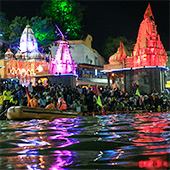The major event of the festival is ritual bathing at the banks of the river in whichever town Kumbh Mela is being held. Another major event of the Kumbh Mela is the Peshwai Procession, which marks the arrival of the members of an akhara or sect of sadhus at the Kumbh Mela. The sadhus are seen clad in saffron sheets with Vibhuti ashes dabbed on their skin as per the requirements of ancient traditions. Some, called Naga sanyasis (saints), may not wear any clothes even in severe winter. The right to be naga, or naked, is considered a sign of separation from the material world. There are other sadhus like Urdhwavahurs, who believe in putting the body through severe austerities, Parivrajakas, who have taken a vow of silence, and Shirshasins, who stand 24 hours and meditate for hours standing on their heads, Kalpvasis, who bathe thrice a day. Apart from sadhus, various akharas made it to the river for the great bath on Kumbh days. It is an organization of the different sects of saints, Vairagis, and yogis who have renounced the world. Akharas are divided into different camps according to the concept of God they worship. Shaiva Akharas are for followers of Lord Shiva, Vaishnava or Vairagi Akhara are for followers of Lord Vishnu and Kalpwasis are for followers of Lord Brahma. Apart from them, one can also see sadhus performing impossible acts of penance on the tree, lifting a hand in the air for 20 years continuously, lifting a leg for years, folding a leg for years, burying ahead in the ground etc.
Darshana, or auspicious sight, is an important part of the Kumbh Mela. People make the pilgrimage to the Kumbh Mela specifically to see and experience both the religious and secular aspects of the event. Two major groups that participate in the Kumbh Mela include the Sadhus (Hindu holy men) and pilgrims. Through their continual yogic practices, the Sadhus articulate the transitory aspect of life. Sadhus travel to the Kumbh Mela to make themselves available to much of the public. This allows members of the public to interact with the Sadhus and to take "Darshana." They are able to "seek instruction or advice in their spiritual lives." The Kumbh Mela is arranged in camps that give worshipers access to the Sadhus. The Darshana is important to the experience of the Kumbh Mela. After taking the dip people to visit the temples situated on the banks of the river or nearby places.


